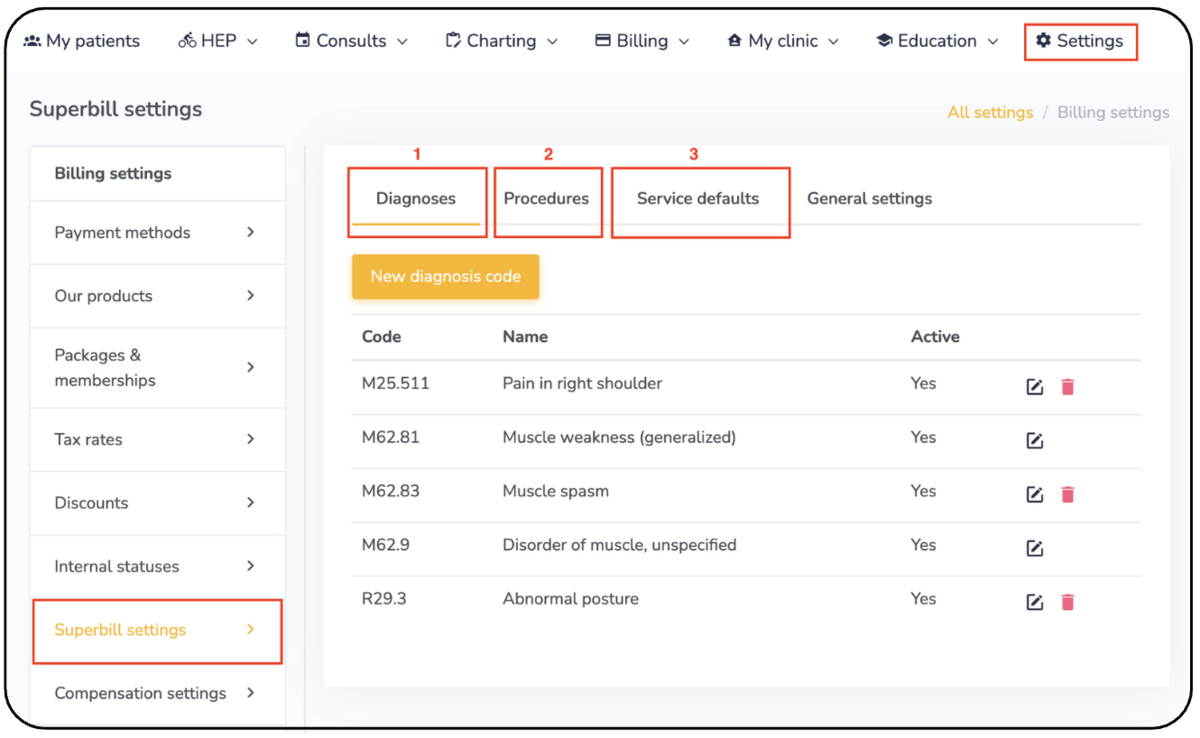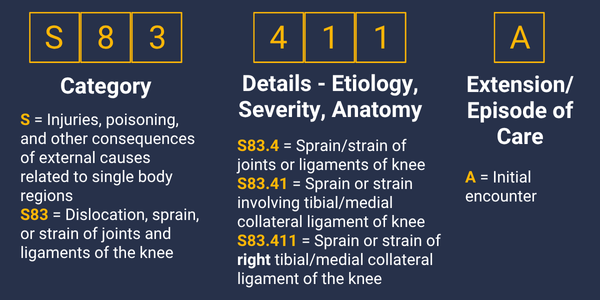A Superbill Glossary for Physical Therapists: Your Go-To Cheat-Sheet for Your Cash-Based Practice
By: Sonia Gavrilova, 2nd year UofT MScPT student ∙ Estimated reading time: 9 minutes
By: Sonia Gavrilova, 2nd year UofT MScPT student ∙ Estimated reading time: 9 minutes
Cut Through the Noise
Tired of spending hours piecing together Superbills manually, only to miss important information or face insurance claim rejections?
Or maybe you’re struggling to keep your billing organized with scattered Google Docs or outdated, clunky software?
![]()
If you’re building a cash-based practice or frustrated with your current system,
we’re here to tell you that we have the answer:
An efficient, streamlined platform that can handle billing seamlessly.

Don’t get us wrong: We at Embodia also love a challenge, and while we know that you work really hard, we would love to help you work smart too.
For all Tier 3 members and US clinicians who are building their practice management systems or not yet satisfied with your current solutions: This one’s for you!
This Superbill glossary cuts through the noise, giving you the codes and tools you need to streamline your billing - so you can get back to what really matters: Providing the best care to your patients.
Quick Recap: What’s a Superbill?
Let’s do a quick refresher!
A Superbill is an itemized receipt that enhances your cash-based practice. Used by healthcare providers, it documents services for patients who pay out-of-pocket.
These receipts include diagnosis codes (ICD-10), procedure codes (CPT), provider information (that's you!), and patient details.
Patients can submit them to their insurance for potential reimbursement, making them essential for your practice.
Using the correct codes ensures smooth processing and reimbursement, so knowing and using them accurately is vital for a successful cash-based practice.

It’s that critical document that bridges the gap between the excellent care you delivered and potential patient reimbursement (bonus points!).
Just as a handshake seals an agreement, a thorough and well-prepared Superbill - with the right diagnosis and procedure codes - ensures that all parties shake on it.
Superbill Setup Made Simple
Get started with superbills on Embodia
Since we’re all friends here, I just couldn’t resist the alliteration.
On Embodia’s all-in-one practice management system, you can use the Superbills feature to generate Superbills, generate new diagnosis codes and procedure codes, and manage or update those codes whenever you need!
While sorting through all the ICD-10 codes and CPT codes might seem like a challenge, setting up Superbills on Embodia is the complete opposite: Just set the right code and watch your workflow flow!
Setting up Diagnosis and Procedure Codes
Your Embodia account comes preloaded with common diagnosis and procedure codes, saving you the legwork!
To set up additional diagnosis codes (#1 in image below), all you need to do is fill out the form in “Diagnoses” with the code, based on ICD-10 (listed below) and the corresponding diagnosis.
For any additional procedure codes you'd like to add (#2 in image below), go to the “Procedures” tab, click on “New Procedures,” and input the CPT code, the name of the procedure, and its unit price.

As always, we want you to be one step ahead.
That’s why we created “Service Defaults,” (#3 in image above) or collections of Superbill procedure codes that are frequently used for the same service. What does this mean? You guessed it!
![]()
You can generate Superbills that much faster,
since there is no need to input the procedure codes every single time that service is provided.
Simple, streamlined, seamless!

Check out this quick, easy-to-follow guide to learn more about setting up Superbills on Embodia.
Decode the Diagnosis: Let’s Talk ICD-10 Codes
What are physical therapy ICD-10 codes?
Sit down, class is now in session!
If you are a practicing physical therapist in the United States, you will definitely be familiar with plugging these codes in for the billable services you provide.
The International Classification of Disease, 10th Revision (ICD-10) is a collection of diagnosis, symptom, and procedure codes used by physical therapists.
Think of these codes like a language that both you, the practitioner, and the insurance company speak: They help the insurance company understand what care you are providing, and why it is medically relevant to the patient.
Wink, wink, nudge, nudge - medically relevant means reimbursable.
These codes help promote:
-
Specificity of diagnosis: Having many codes, some of which describe the primary condition, and others which relate to specific symptoms, allow for a very accurate description of your patient’s condition.
-
Standardization in documentation: Using a universal language for diagnoses allows patient records to stay consistent and precise, thereby guiding treatment decisions and progress tracking.
-
Efficiency in billing and reimbursement: Correct coding is incredibly important to generate clear, straight-to-the-point Superbills, which will help minimize billing errors and claim rejections.
-
Compliance and accountability: ICD-10 codes help with staying compliant with regulatory standards and providing thorough, professional care, which safeguards against any potential audits or penalties (yikes).
The Anatomy of the ICD-10 Code
If there’s one thing physical therapists have drilled into their brains, it’s the importance of anatomy. So, we figured, let’s break it down to the bare bones.
Notepad and pen ready?
Let’s check out an example (pictured below).
1. Category (Characters 1-3)
Generally speaking, ICD-10 codes can have between three and seven characters, with the initial three-character codes being used for categories of codes that can expand into more characters.
The first three characters always indicate the category of the diagnosis itself.
In our example, “S” relates to injuries, poisoning, and other external causes. More specifically, “S8” refers to “injuries of the knee and lower leg,” and the final number “3” in our code specifies that this is an injury to the “joints and ligaments of the knee.”
2. Details (Characters 4-6)
These subsequent characters provide more insight into the etiology, anatomic site, and severity of the condition specified in the initial three characters.
This is the part that makes your coding specific to the unique patient you’re seeing.
The “4” in our code below indicates a sprain or strain, while “11” communicates that it is an injury to the right medial collateral ligament (ah yes, the anatomy we’re truly familiar with).
3. Extension (Character 7)
The seventh character in the series makes things even more specific - it communicates the nature of the encounter.
The “A” at the end of our example signifies that this is an initial encounter with the patient.

Examples of Common ICD-10 Codes in Physical Therapy
Here is a handy cheat sheet with the most common ICD-10 codes for physiotherapists.
Pelvic-specific codes are listed at the end of the table!
|
Category |
ICD-10 Code |
Description |
|
Back and Spine |
M54.5 |
Low back pain |
|
M54.2 |
Cervicalgia (neck pain) |
|
|
M51.26 |
Intervertebral disc disorders with radiculopathy, lumbar region |
|
|
Shoulder and upper extremity |
M75.101 |
Unspecified rotator cuff tear or rupture of right shoulder, not specified as traumatic |
|
M75.41 |
Impingement syndrome of the right shoulder |
|
|
M77.11 |
Lateral epicondylitis (tennis elbow) of the right elbow |
|
|
S43.401A |
Sprain of right shoulder joint, initial encounter |
|
|
Knee and lower extremity |
M17.11 |
Unilateral primary osteoarthritis, right knee |
|
S83.261A |
Anterior cruciate ligament sprain, right knee, initial encounter |
|
|
M76.61 |
Achilles tendinitis; right leg |
|
|
M25.561 |
Pain in right knee |
|
|
Neurological conditions |
G35 |
Multiple sclerosis |
|
G20 |
Parkinson’s disease |
|
|
I69.351 |
Hemiplegia and hemiparesis following cerebral infarction affecting the right dominant side |
|
|
G61.0 |
Guillain-Barré syndrome |
|
|
Pediatric Conditions |
F82 |
Specific developmental disorder of motor function |
|
R26.9 |
Unspecified abnormalities of gait and mobility |
|
|
R62.0 |
Delayed milestone in childhood |
|
|
Injuries |
S43.421A |
Sprain of right rotator cuff capsule, initial encounter |
|
S93.401A |
Sprain of right ankle, unspecified ligament, initial encounter |
|
|
General Symptoms and Signs |
R26.2 |
Difficulty in walking, not elsewhere classified |
|
R29.3 |
Abnormal posture |
|
|
M62.81 |
Muscle weakness (generalized) |
|
|
R26.89 |
Other abnormalities of gait and mobility |
|
|
M79.1 |
Myalgia |
|
|
Common pelvic codes |
N39.3 |
Stress incontinence (female) (male) |
|
R10.2 |
Pelvic and perineal pain |
|
|
N39.41 |
Urge incontinence |
|
|
N39.46 |
Mixed incontinence |
|
|
R15.9 |
Full incontinence of feces |
|
|
K59.00 |
Constipation, unspecified |
|
|
O90.4 |
Postpartum perineal pain |
|
|
N94.1 |
Dyspareunia |
From Code to Care: an Introduction to CPT Codes
Current Procedural Terminology (CPT) codes are your one-stop shop to quickly summarize and describe medical, surgical, and diagnostic services provided by healthcare professionals.
These codes serve as a uniform language to streamline medical reporting, increase accuracy of documentation, and make billing and patient reimbursement that much easier!
The Anatomy of the CPT Code
Let’s dissect this one, folks!
CPT codes are a little more straightforward than the ICD-10 codes, since they are five characters long (ahem, not seven) and divided into three general categories:
-
Category I: This is the meat and potatoes of the code. These codes have descriptors that are focused on specific procedures or services. They are generally organized into sub-categories based on the procedure, type of service provided, and anatomy.
-
Category II: This category is like the cherry on top! These codes are alphanumeric and serve as supplemental codes used for performance measurement. They are also optional and are not required for correct or effective coding.
-
Category III: These codes are a rare breed. They are temporary and are used for new or developing technologies, procedures, or services. These codes are specifically created for data collection, assessment, billing, and payment for new services and procedures that have not yet become Category I codes.
Examples of Common CPT Codes in Physical Therapy
|
Type of Code |
CPT Code |
Description |
|
Treatment Codes |
97110 |
Therapeutic Exercise |
|
97112 |
Neuromuscular Re-Education |
|
|
97116 |
Gait Training |
|
|
97140 |
Manual Therapy |
|
|
97150 |
Group Therapy |
|
|
97530 |
Therapeutic Activities |
|
|
Evaluation Codes |
97161 |
Low Complexity |
|
97162 |
Moderate Complexity |
|
|
97163 |
High Complexity |
|
|
97164 |
Re-Evaluation |
|
|
Other Common Codes |
97750 |
Physical Performance Test or Measurement |
|
97535 |
Self Care/Home Management Training |
Code Confidently: Quick Tips and Tricks for Flawless Billing
Remember that, with coding, there are a few very important tips to keep in mind:
-
Get down to the nitty gritty. The more specific, the better! Using the most detailed CPT code or ICD-10 code possible to help describe your patient’s condition or the service provided will accurately capture the diagnosis or treatment, thereby communicating it effectively to insurance companies.
-
The more, the merrier. Use multiple codes when needed! Don’t hesitate to use multiple ICD-10 codes if you feel that this helps you accurately capture the patient’s condition! Provide the primary reason for the encounter, followed by any other coexisting conditions.
-
Tell a story. Make sure your documentation supports the CPT codes billed. Your treatment notes should justify why you’re using those specific CPT codes. For example, if billing “97140” (Manual Therapy), list the specific techniques you used, the body areas treated, and the clinical rationale for the treatment.
-
Check out Embodia’s Superbill feature to learn how to minimize the amount of time spent coding while maximizing specificity; simply save the codes you use time and time again!
Ready? Start Coding with Confidence!
With this CPT and ICD-10 code cheat sheet, you can streamline your billing process in your cash-based practice and focus on providing excellent patient care.
No more spending hours managing codes and creating Superbills from scratch; you now have the tools to code confidently!
Embodia’s all-in-one practice management system offers a variety of resources that make billing smooth and simple.
Check out this guide for an overview of Embodia’s features for Superbills or this step-by-step setup guide.
Ready to enhance your billing? Dive into your practice management with renewed confidence and transform your workflow for the better!
![]()
Let’s make coding the easiest part of your day!

Interested in learning more about how Embodia can enhance your practice?
Book my free Embodia demo
Here are some additional resources and links to check out:
- A Beginner's Guide to Superbills and Receipts for Cash Practice
- Introduction to Superbills on Embodia
- Embodia's Practice Management Features
- ICD-10 Website
- CPT Codes and the American Medical Association
---
Date published: 13 Nov 2024
Last update: 4 December 2025
